Good Q3 reports for S&P500, worse for OMX

Tesla delivered a Q3 2024 report that was solid but not exceptional. The outlook is for strong growth in 2025, supported by increased production capacity and attractive car loans. The Q3 2024 reporting season has shown good results for S&P500 companies, but not so good for OMX companies. This week also sees the big US tech companies start to report their Q3 earnings.
Case of the week: Tesla’s Electric Dreams
Tesla exceeded market expectations with its Q3 2024 earnings, reporting robust revenue growth and notable margin improvement. CEO Elon Musk outlined Tesla's roadmap for deploying Full Self-Driving (FSD) and expanding its driverless vehicle fleet, highlighting the company’s growing economies of scale within the Energy Generation and Storage segment. Looking beyond 2024, continued strength in this segment as operations expand in Shanghai, alongside growth in the Automotive segment driven by the launch of Tesla's affordable electric vehicle are expected.
During Tesla's Q3 2024 earnings call, Elon Musk indicated that the company remains on track to release more affordable models in early 2025. This development could significantly boost vehicle sales, as price remains one of the main barriers to wider Electric Vehicle (EV) adoption. Ford, for example, saw a surge in sales of its Mach-E model in Q1 2024 following a 17% price cut.
Despite occasional markdowns, Tesla has maintained profitability across its vehicle range. Musk expects vehicle volumes to grow by 20-30% in 2025, driven by the introduction of lower-cost models. Given the recent margin improvements in Q3 2024, it will be important to consider whether these more affordable vehicles will contribute to overall margin growth. The new models are expected to cost consumers less than $30,000 after incentives, making them competitive with internal combustion vehicles. In addition, the ramp-up of Cybertruck production will help offset any margin compression from Tesla's low-cost offerings, potentially improving margins towards the end of 2024.
Tesla saw significant growth in its Energy Generation & Storage segment in Q3 2024, driven by high demand for its Megapacks and Powerwalls. According to the Q3 earnings call, production at the Lathrop Megapack factory in California has ramped up to 200 Megapacks per week, reaching an annual run rate of 40 GWh. Once the Shanghai factory is fully ramped up, Elon Musk expects stationary storage production to reach 100 GWh per year.
For the remainder of 2024, the consensus expects Tesla to generate total revenue of approximately $100 billion, driven by growth in both its Energy Generation and Storage segment and its Services division. Looking beyond 2024, analysts see potential for Tesla to leverage increased sales of lower-cost vehicles alongside strong momentum in its Energy Generation segment.
Tesla's share price is up around 6% in 2024. After a weak start to the year, the share price has risen by around 85% since mid-April. A number of factors suggest that this positive trend could continue as Tesla expands its energy production and storage capacity, with its Shanghai facility coming on stream alongside expanded production at its US site. In the automotive segment, Tesla offers in-house financing options that can offer more attractive rates than standard bank loans, making vehicle purchases more accessible to consumers. With the introduction of a low-cost model, Tesla is seeking to reach a broader market by offering EV options to lower-income consumers, thereby expanding its total addressable market of vehicle buyers.
On the other hand, Teslas plans to scale production of its low-cost model could impact margins during the ramp-up phase due to pricing and cost factors. Additionally, rising geopolitical tensions may pose challenges for Tesla’s operations in China, potentially affecting how the company conducts business there if tensions escalate. These are two risk-factors that could potentially hamper the share price going forward.
In summary, Tesla's Q3 results were solid but not extraordinary. The key takeaway is the strong growth forecast for 2025, which helps justify a continued positive trend going forward.
Tesla (in USD), one-year daily chart

Tesla (in USD), five-year weekly chart
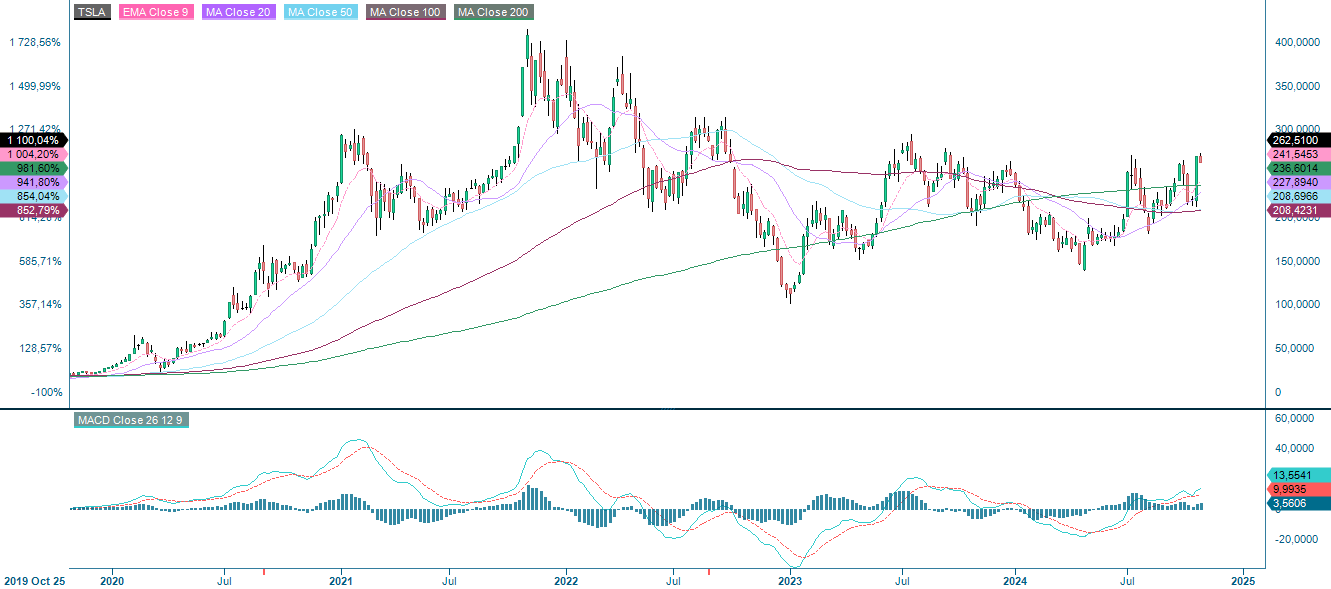
Macro comments
The yield on 10-year US Treasuries remained relatively high, rising from 3.73% on 1 October to 4.27% on 29 October this year. This is explained by the increased likelihood of a "red sweep", i.e. Trump winning the presidential election and the Republicans gaining a majority in the US Congress. Such an outcome would likely lead to higher economic growth, but also higher inflation, which would benefit cyclical stocks.
For Q3 2024 (with around 185 S&P500 companies reporting), 75% of companies have reported a positive earnings surprise, while 59% have reported a positive revenue surprise. So far, the market is rewarding positive earnings surprises reported by S&P500 companies slightly more than average. Meanwhile, the market is also punishing negative earnings surprises reported by S&P500 companies more than average.
Utilities is the best performing S&P500 sector so far, beating Q3 earnings expectations in 100% of reports to date. Information Technology is second, with 94% of Q3 earnings beating estimates. Communication Services could be considered third best, since the sector had 83% positive earnings surprises, 17% in-line and 0% negative earnings surprises. Measured as % of net positive earnings surprise, materials, consumer discretionary and real estate had the lowest scores among the eleven S&P500 sectors.
We have also received Q3 2024 results from 76 Swedish OMX companies as of Tuesday 29 October 2024. Of these, only 45% beat consensus estimates, while 53% missed expectations. When it comes to sales, the results are even worse, with only 39% beating and 61% missing expectations. For order intake, there have been twelve observations, of which 50% each beat and missed consensus estimates.
On Wednesday, 30 October, Q3 Gross Domestic Product (GDP) from the Eurozone, France, Italy, Spain and Germany are on the macroeconomic agenda. From Spain and Germany we also get Consumer Price Index (CPI) for October. We also get October economic indicators from the Eurozone, as well as German unemployment in September. The US contributes with Automatic Data Processing (ADP) private employment in October, GDP for Q3, pending home sales in September and oil inventories from Department of Energy’s (DOE) weekly statistics. Wednesday will also see interim reports from Microsoft, Meta Platforms, Eli Lilly, Abbvie, Caterpillar, Amgen, HSBC, Schneider Electric, Volkswagen, SKF, Sweco, Scandic Hotels, Telenor, Outokumpu, Valmet, Aker BP, Kesko and Sydbank.
On Thursday, 31 October, the macro agenda starts from Japan with September industrial production and retail sales as well as an interest rate announcement from the Bank of Japan. Also out of China in the early morning will be the October Purchasing Managers' Index (PMI). In Europe, the morning brings retail sales, import prices and Verband Deutscher Maschinen- und Anlagenbau (VDMA) machinery orders for September from Germany. France, Italy and the eurozone will report CPI for October. The US will contribute with September private consumption and inflation (Personal Consumption Expenditures), Q3 labour costs, initial jobless claims and the Chicago PMI for October. The flood of Q3 reports continues with results from Apple, Amazon, Intel, Mastercard, Merck and Shell.
Friday 1 November will see the release of October industrial PMIs from Japan, China, India, Russia, Sweden, the UK and the US. The US will also release its Non-Farm Payrolls for October, where expectations are as low as 111,000 new jobs. In addition, Exxon Mobil, Chevron, Enbridge and Mitsubishi are due to release interim reports.
US nonfarm payrolls (in thousands), January 2023 to October 2024
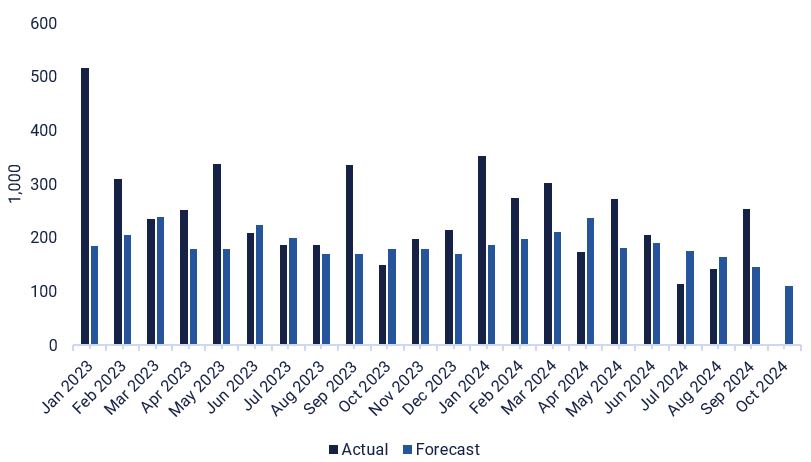
Q3 tech reports and US payrolls could cause volatility
The S&P 500 has rallied and is currently trading just above the zero line following strong US consumer confidence figures that beat estimates. In addition to reports from Microsoft and Meta today, and Apple and Amazon on Thursday, Friday's US employment data could cause volatility. Expectations for the US nonfarm payrolls appear to be low. Deviations from consensus estimates are likely to affect expectations for future Fed rate cuts, which could lead to volatility in equity markets. The first level of support for S&P500 is the MA20, currently at 5,800. The next level of support is at 5,693, which is formed by the MA50.
S&P 500 (in USD), one-year daily chart
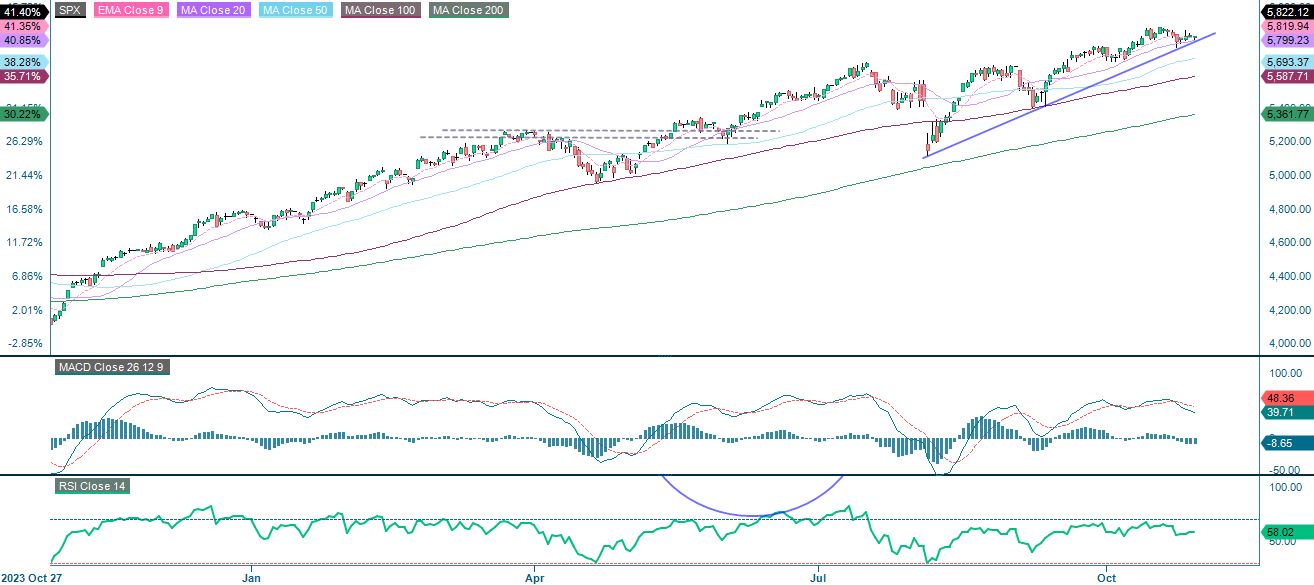
S&P 500 (in USD), weekly five-year chart
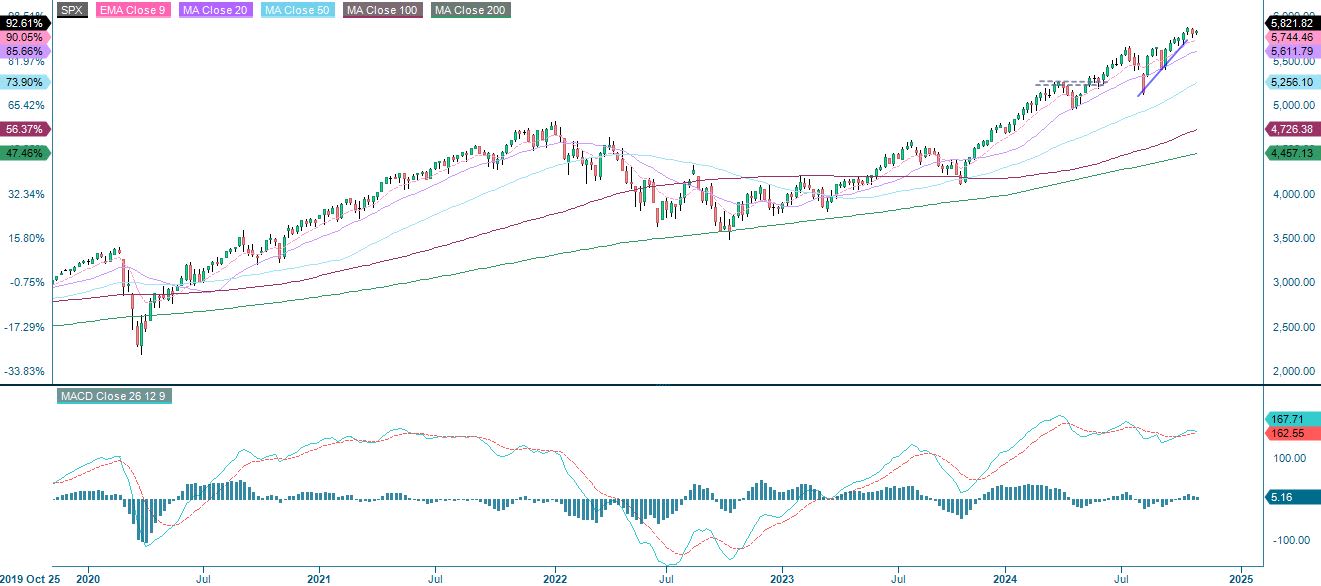
The Nasdaq 100 continues to consolidate a head of big tech reports and US job figures. The first level of support is around 20,187, where MA20 meet up, followed by 19,766, where MA50 meet up.
Nasdaq 100 (in USD), one-year daily chart
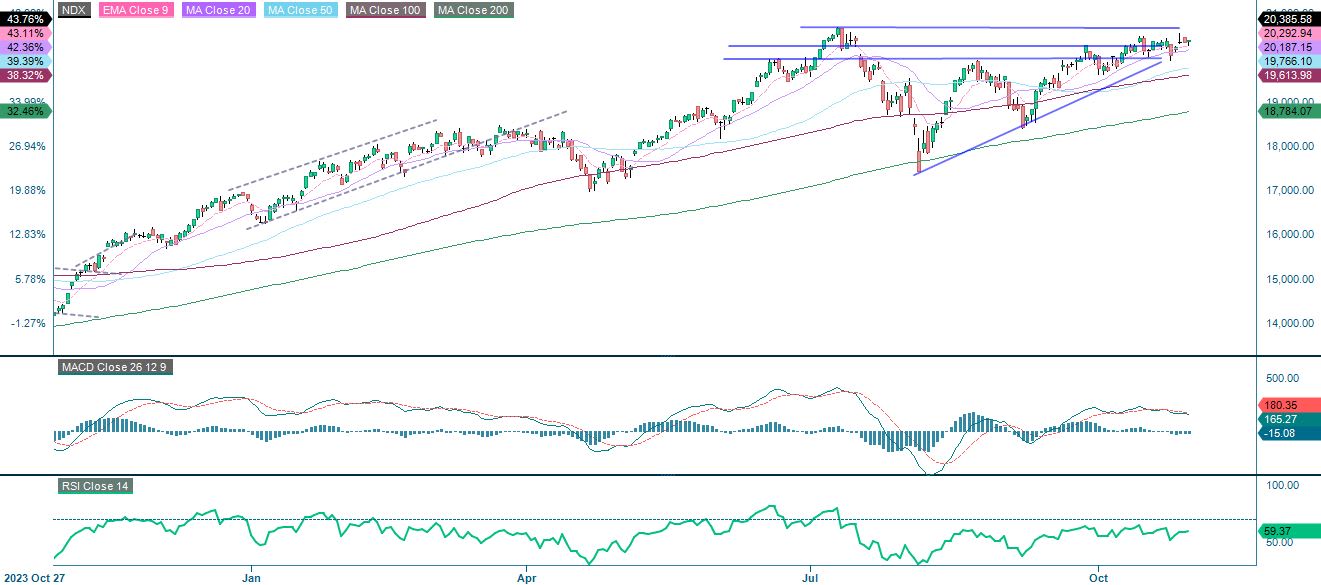
Nasdaq 100 (in USD), weekly five-year chart
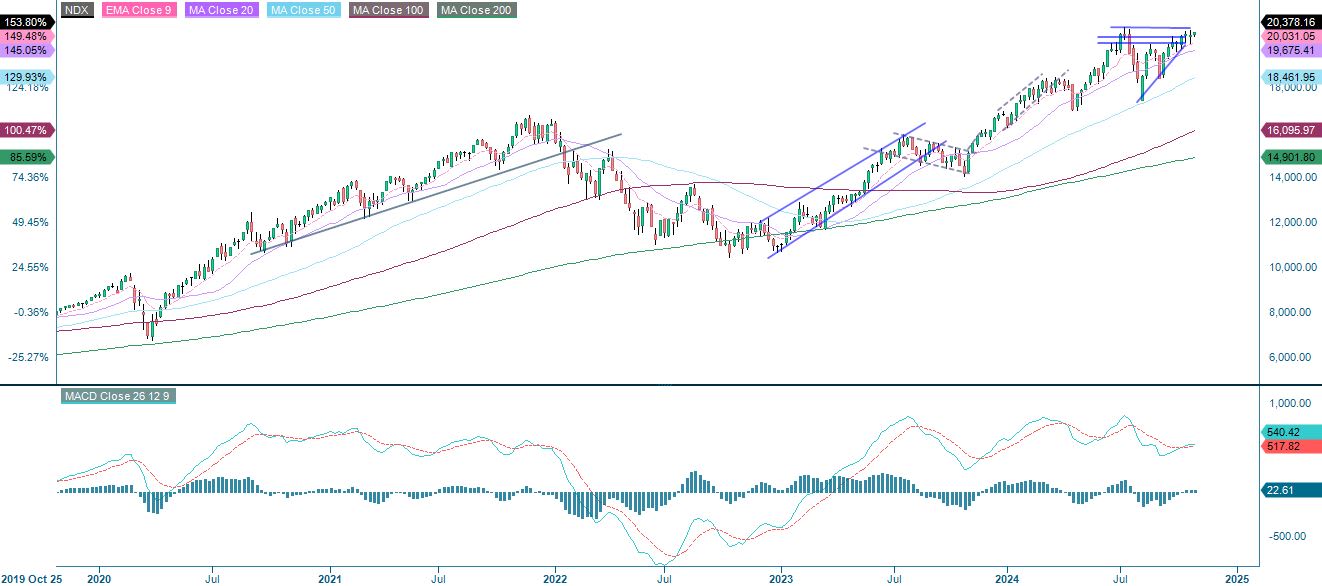
The German DAX is consolidating above EMA9 as well as MA20 under positive but waning momentum. First support is at 19,340, followed by 19,000. Quarterly reports and US Non-Farm Payrolls are also likely to influence European equity indices.
DAX (in EUR), one-year daily chart
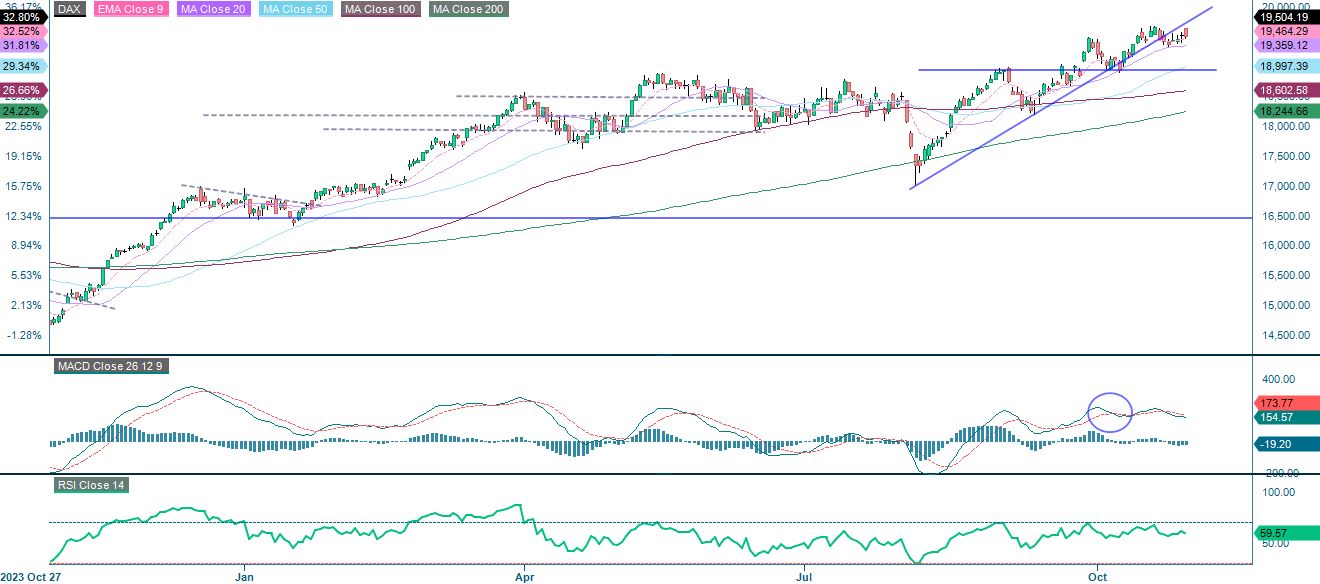
DAX (in EUR), weekly five-year chart
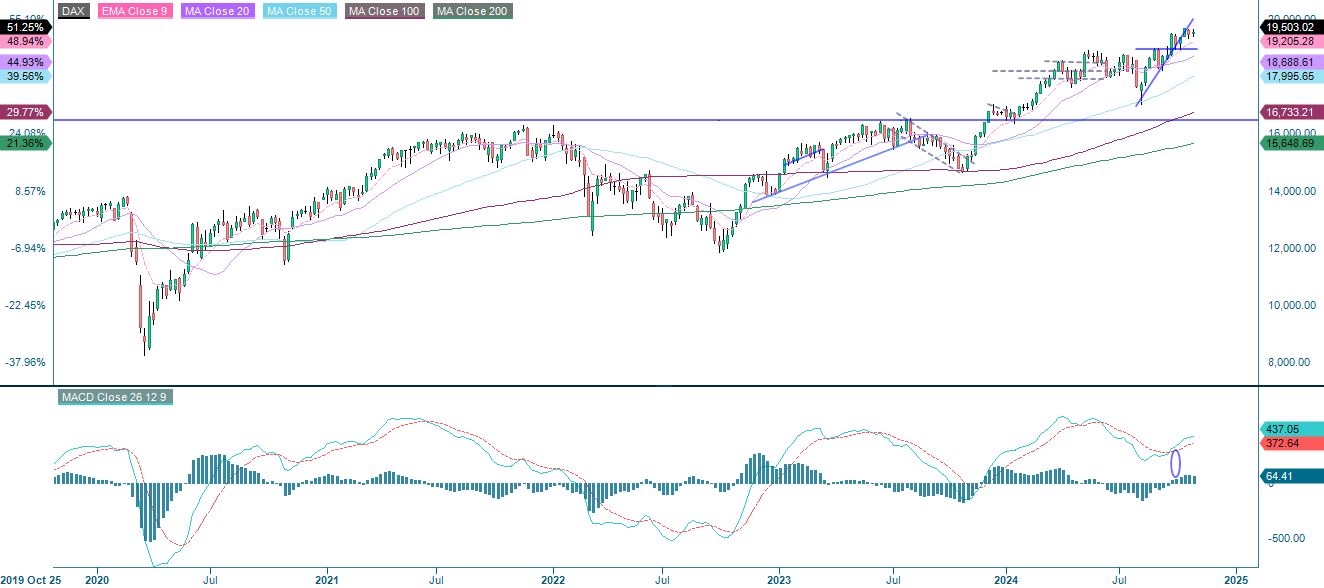
The OMXS30 is back above the MA20, while the MACD has given a soft buy signal in positive territory. However, the index is currently bearish on weak GDP data. On a more positive note, the Riksbanken interest rate decision is due on 7 November. The market is currently pricing in a 50 basis point rate cut with a probability of around 50%.
OMXS30 (in SEK), one-year daily chart
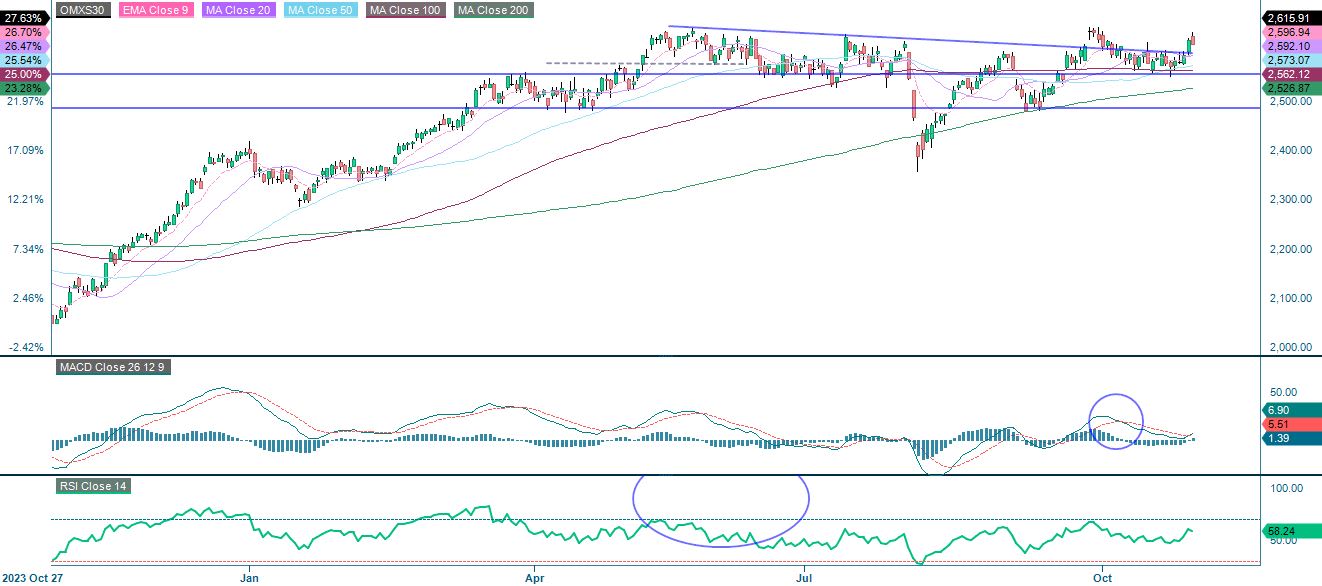
OMXS30 (in SEK), weekly five-year chart
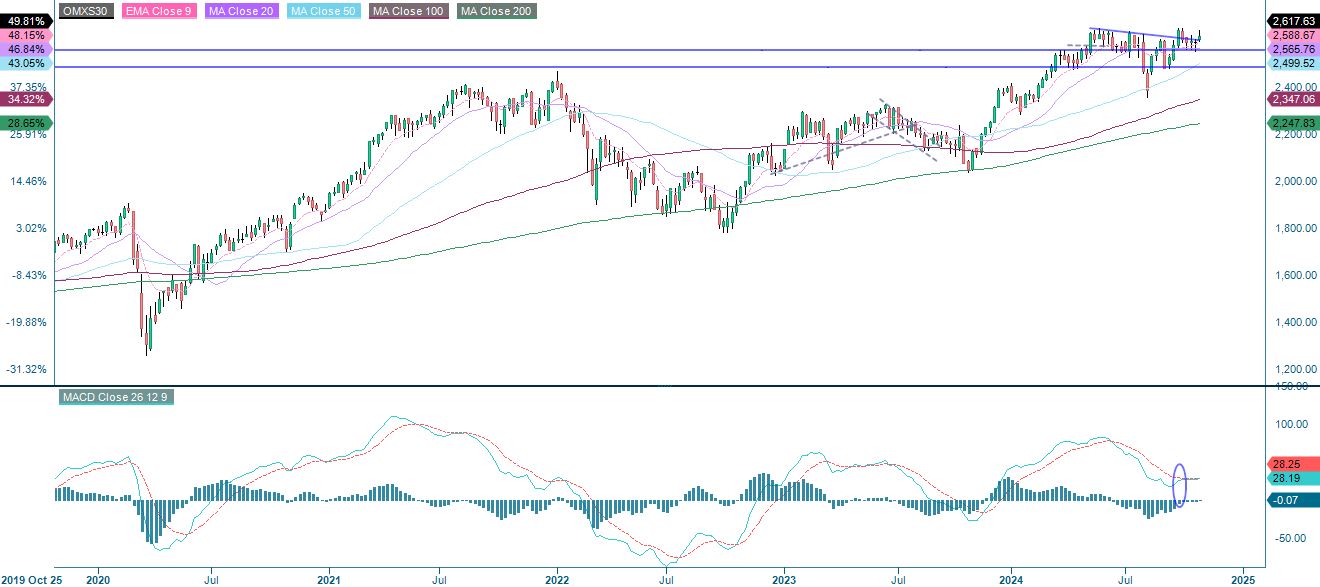
The full name for abbreviations used in the previous text:
EMA 9: 9-day exponential moving average
Fibonacci: There are several Fibonacci lines used in technical analysis. Fibonacci numbers are a sequence in which each successive number is the sum of the two previous numbers.
MA20: 20-day moving average
MA50: 50-day moving average
MA100: 100-day moving average
MA200: 200-day moving average
MACD: Moving average convergence divergence
Risks
Credit risk of the issuer:
Investors in the products are exposed to the risk that the Issuer or the Guarantor may not be able to meet its obligations under the products. A total loss of the invested capital is possible. The products are not subject to any deposit protection.
Currency risk:
If the product currency differs from the currency of the underlying asset, the value of a product will also depend on the exchange rate between the respective currencies. As a result, the value of a product can fluctuate significantly.
External author:
This information is in the sole responsibility of the guest author and does not necessarily represent the opinion of Bank Vontobel Europe AG or any other company of the Vontobel Group. The further development of the index or a company as well as its share price depends on a large number of company-, group- and sector-specific as well as economic factors. When forming his investment decision, each investor must take into account the risk of price losses. Please note that investing in these products will not generate ongoing income.
The products are not capital protected, in the worst case a total loss of the invested capital is possible. In the event of insolvency of the issuer and the guarantor, the investor bears the risk of a total loss of his investment. In any case, investors should note that past performance and / or analysts' opinions are no adequate indicator of future performance. The performance of the underlyings depends on a variety of economic, entrepreneurial and political factors that should be taken into account in the formation of a market expectation.
Market risk:
The value of the products can fall significantly below the purchase price due to changes in market factors, especially if the value of the underlying asset falls. The products are not capital-protected
Product costs:
Product and possible financing costs reduce the value of the products.
Risk with leverage products:
Due to the leverage effect, there is an increased risk of loss (risk of total loss) with leverage products, e.g. Bull & Bear Certificates, Warrants and Mini Futures.
Disclaimer:
This information is neither an investment advice nor an investment or investment strategy recommendation, but advertisement. The complete information on the trading products (securities) mentioned herein, in particular the structure and risks associated with an investment, are described in the base prospectus, together with any supplements, as well as the final terms. The base prospectus and final terms constitute the solely binding sales documents for the securities and are available under the product links. It is recommended that potential investors read these documents before making any investment decision. The documents and the key information document are published on the website of the issuer, Vontobel Financial Products GmbH, Bockenheimer Landstrasse 24, 60323 Frankfurt am Main, Germany, on prospectus.vontobel.com and are available from the issuer free of charge. The approval of the prospectus should not be understood as an endorsement of the securities. The securities are products that are not simple and may be difficult to understand. This information includes or relates to figures of past performance. Past performance is not a reliable indicator of future performance.
© Bank Vontobel Europe AG and/or its affiliates. All rights reserved.
